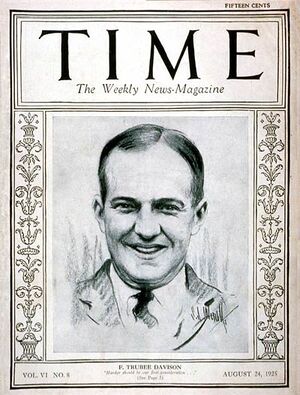F. Trubee Davison
(spook, pilot) | |
|---|---|
 Even back in 1925, getting on the cover of Time Magazine is an indication of being promoted by the US deep state | |
| Born | 7 February 1896 |
| Died | 14 November 1974 (Age 78) |
| Nationality | US |
| Alma mater | Groton School, Yale University, Columbia University Law School |
| Parents | Henry Davison |
| Member of | Links Club, Skull and Bones |
| Relatives | Artemus Gates |
Son of influential banker Henry Davison. Worked with deep state operatives Judge Gary and Bill Donovan. After WW2 Director of Personnel for the CIA.
| |
Frederick Trubee Davison was a US World War I aviator, Assistant United States Secretary of War, Director of Personnel for the Central Intelligence Agency, and President of the American Museum of Natural History.[1] He was son of the influential banker Henry Davison.
World War I
Davison was the founder of the First Yale Unit, which is considered to be the first naval air reserve unit. He founded the unit in 1916 in response to the war that was raging in Europe. Davison and a handful of other students from Yale feared that the United States would soon be dragged into the war effort and would find itself poorly prepared, especially in aviation[2] Frederick also relied on the financial aid provided by his father, Henry P. Davison, and his friends in the form of flying boats and equipment for the Unit.
On July 28, 1917, Davison was set to take his flying test in order to obtain his Navy wings. Having fainted only a short while before the test, Davison was not sure about whether or not he should fly but decided he felt well enough During the flight, he lost control of his seaplane in a panic attack and spiralled into the sea, the impact of which split the plane in two. Davison was admitted to St. Luke's hospital where he was diagnosed with a broken back and injured spinal cord. He would spend six weeks there. Davison never saw combat but was active in unit activities throughout the war and was awarded the Navy Cross for his services.[3]
After World War I
After the war, Davison went back to Yale and, while rooming with fellow Unit member "Di" (Artemus) Gates, finished his undergraduate program graduating in 1919.[4] In 1920, he married Dorothy Peabody, the daughter of the headmaster at Groton School where he had attended before attending Yale. After his father died Trubee and Dorothy built a house on the Davison estate, Peacock Point, in order to keep his mother company.[5]
Davison proceeded to attend Columbia University Law School where he earned a Law Degree and then went on to work with White and Case, Manhattan lawyers.[4]
Davison was elected to the New York State Legislature after the war where he gained a reputation as being one of the hardest-working members. In 1925, he became head of the unofficial "Crime Commission", sponsored by deep politician Judge Elbert H. Gary.[4] The same year, he was on the cover of Time Magazine for the August issue in 1925.[4]
Every year, Davison held a reunion for the First Yale Unit in New York City in the summer and sometimes other naval aviators would attend as well original members.[6]
He was Assistant Secretary of War for Air from July 1926 to March 1933.[7] In the New York state election, 1932, he ran for Lieutenant Governor of New York with later OSS leader William J. Donovan, but they were defeated in a landslide by Democrats Herbert H. Lehman and M. William Bray. Davison was an alternate delegate to the 1940 Republican National Convention.
In 1951, he became a trustee of Yale and the first personnel director of the newly formed CIA.[8][9]
References
- ↑ https://select.nytimes.com/gst/abstract.html?res=FA0D13F9385F137B93C4A8178AD95F408785F9
- ↑ Davison, F. T. (1918). The First Yale Naval Aviation Unit. In G. H. Nettleton (Ed.), Yale in the World War Part One (pg 443-447). New Haven: Yale University Press. pg 443
- ↑ Wortman, M. (2006). The Millionaire's Unit: The Aristocratic Flyboys Who Fought the Great War and Invented American Air Power. New York City: PublicAffairs. pg 41, 81, 115.
- ↑ a b c d https://web.archive.org/web/20121019144527/http://www.time.com/time/magazine/article/0,9171,720818-1,00.html
- ↑ Wortman, M., The Millionaire's Unit, p. 267.
- ↑ Wortman, M., The Millionaire's Unit, p. 274.
- ↑ Time magazine. (1926, July 12). National Affairs: Progress.
- ↑ http://www.millionairesunit.org/index.php?option=com_content&task=view&id=23&Itemid=36
- ↑ https://archives.yale.edu/repositories/12/resources/4056